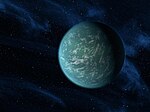SDSS J102915+172927
| Observation data Epoch J2000.0 Equinox J2000.0 | |
|---|---|
| Constellation | Leo |
| Right ascension | 10h 29m 15.1490s[1] |
| Declination | +17° 29′ 27.925″[1] |
| Apparent magnitude (V) | +16.92 |
| Characteristics | |
| B−V color index | 0.03[2] |
| Astrometry | |
| Proper motion (μ) | RA: −10.720(63) mas/yr[1] Dec.: −3.921(54) mas/yr[1] |
| Parallax (π) | 0.6482 ± 0.0598 mas[1] |
| Distance | 5,000 ± 500 ly (1,500 ± 100 pc) |
| Details | |
| Mass | ≤ 0.8 M☉ |
| Temperature | 5811[2] K |
| Metallicity | ≤ 6.9×10−7[2] |
| Other designations | |
2MASS J10291514+1729278 | |
| Database references | |
| SIMBAD | data |
SDSS J102915+172927 or Caffau's Star is a population II star in the galactic halo, seen in the constellation Leo. It is about 13 billion years old, making it one of the oldest stars in the Galaxy.[3] At the time of its discovery, it had the lowest metallicity of any known star.[4] It is small (less than 0.8 solar masses),[5] deficient in carbon, nitrogen, oxygen, and completely devoid of lithium. Because carbon and oxygen provide a fine structure cooling mechanism that is critical in the formation of low-mass stars, the origins of Caffau's Star are somewhat mysterious. It has been suggested, both for theoretical and observational reasons, that the formation of low-mass stars in the interstellar medium requires a critical metallicity somewhere between 1.5×10−8 and 1.5×10−6.[6]
The metallicity of Caffau's Star is less than 6.9×10−7.[6] According to Schneider et al., cooling by dust rather than the fine structure lines of CII and OI may have enabled the creation of such low-mass, metal-poor stars in the early universe.[5][7] The absence of lithium implies past temperatures of at least two million kelvins.[6]
Data from Gaia's DR2 released in 2018 confirmed that SDSS J102915+172927 is a dwarf star.[2]
The star was described by Elisabetta Caffau et al. in an article published by the journal Nature in September 2011. Caffau had been searching for extremely metal-poor stars for the past ten years.[8] It was identified by automated software which analyzed data from the Sloan Digital Sky Survey. This was followed up by observations with the X-shooter and UVES instruments on the Very Large Telescope in Chile.[4] As of 2011[update] Caffau and her team expect to find between five and fifty similar stars with the telescope in the future.[7][needs update]
See also
[edit]- Ultra low metallicity / ultra metal poor stars
References
[edit]- ^ a b c d Vallenari, A.; et al. (Gaia collaboration) (2023). "Gaia Data Release 3. Summary of the content and survey properties". Astronomy and Astrophysics. 674: A1. arXiv:2208.00211. Bibcode:2023A&A...674A...1G. doi:10.1051/0004-6361/202243940. S2CID 244398875. Gaia DR3 record for this source at VizieR.
- ^ a b c d Bonifacio, P.; Caffau, E.; Spite, M.; Spite, F.; François, P.; Zaggia, S.; Arenou, F.; Haigron, R.; Leclerc, N.; Marchal, O.; Panuzzo, P.; Plum, G.; Sartoretti, P. (2 May 2018). "Gaia Confirms that SDSS J102915+172927 is a Dwarf Star". Research Notes of the AAS. 2 (2): 19. arXiv:1804.10419. Bibcode:2018RNAAS...2...19B. doi:10.3847/2515-5172/aac0f4. S2CID 85449621.
- ^ Lemonick, Michael D. (2011-09-06). "Cosmic Anomaly: The Star That Shouldn't Exist". TIME. Archived from the original on September 7, 2011. Retrieved 2012-08-20.
- ^ a b "The Star That Should Not Exist". ESO. 2011-08-31. Retrieved 2012-08-20.
- ^ a b Schneider, Raffaella; et al. (2012-03-19). "The formation of the extremely primitive star SDSS J102915+172927 relies on dust". Monthly Notices of the Royal Astronomical Society: Letters. 423 (1): L60 – L64. arXiv:1203.4234. Bibcode:2012MNRAS.423L..60S. doi:10.1111/j.1745-3933.2012.01257.x. S2CID 119248436.
- ^ a b c Caffau, Elisabetta; Bonifacio, Piercarlo; François, Patrick; Sbordone, Luca; et al. (1 September 2011). "An extremely primitive star in the Galactic halo". Nature. 477 (7362): 67–69. arXiv:1203.2612. Bibcode:2011Natur.477...67C. doi:10.1038/nature10377. PMID 21886158. S2CID 118554326.
- ^ a b Doyle, Amanda (2011-09-01). "A forbidden star". Astronomynow.com. Archived from the original on 2012-10-19. Retrieved 2012-08-20.
- ^ Redd, Nola Taylor (2011-08-31). "Impossible Star Defies Astronomers' Theories". Space.com. Retrieved 2012-08-20.




